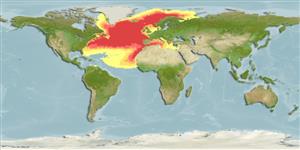Classification / Names
Common names from other countries
Main reference
Size / Weight / Age
Max length : 10.3 cm SL male/unsexed; (Ref. 4479); max. reported age: 8 years (Ref. 35388)
Environment
Marine; pelagic-oceanic; non-migratory; depth range 0 - 1407 m (Ref. 58426), usually 300 - 400 m (Ref. 82363)
Climate / Range
Deep-water, preferred ?; 81°N - 11°N, 76°W - 29°E
Distribution
Eastern Atlantic: Norway and Greenland south to Morocco, and from Mauritania to Guinea (Mauritanian Upwelling Region). Seasonally present from Morocco to Mauritania along the edge of the continental shelf. Also known from the Mediterranean Sea. Western Atlantic: Baffin Bay to northern edge of Gulf Stream. Northwest Atlantic: Canada (Ref. 5951).
Countries | FAO areas | Ecosystems | Occurrences | Introductions
Short description
Dorsal
spines
(total): 0;
Dorsal
soft rays
(total): 13-14;
Anal
soft rays: 17 - 19. Males with single black-bordered supracaudal gland; females with two infra-caudal luminous patches; occasional specimens with both. Luminous organs in the anal area, 5-6 anteriorly and 5-7 posteriorly, 11-13 total.
IUCN Red List Status (Ref. 115185)
Threat to humans
Harmless
Human uses
Fisheries: of potential interest
Tools
Special reports
Download XML
Internet sources
Estimates of some properties based on models
Phylogenetic diversity index
PD50 = 0.5312 many relatives (e.g. carps) 0.5 - 2.0 few relatives (e.g. lungfishes)
Trophic Level
3.0 ±0.29 se; Based on food items.
Resilience
Medium, minimum population doubling time 1.4 - 4.4 years (K=0.20-0.45; tm=2-3; tmax=8; Fec=700)
Vulnerability
Low to moderate vulnerability (27 of 100)
Price category
